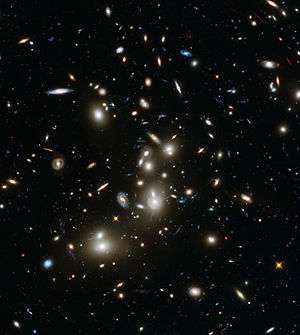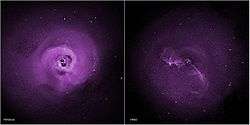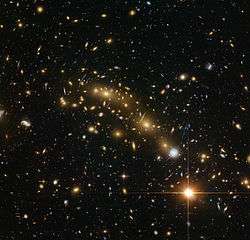Galaxy cluster

A galaxy cluster, or cluster of galaxies, is a structure that consists of anywhere from hundreds to thousands of galaxies that are bound together by gravity[1] with typical masses ranging from 1014–1015 solar masses. They are the largest known gravitationally bound structures in the universe and were believed to be the largest known structures in the universe until the 1980s, when superclusters were discovered.[2] One of the key features of clusters is the intracluster medium (ICM). The ICM consists of heated gas between the galaxies and has a peak temperature between 2–15 keV that is dependent on the total mass of the cluster. Galaxy clusters should not be confused with star clusters, such as open clusters, which are structures of stars within galaxies, or with globular clusters, which typically orbit galaxies. Small aggregates of galaxies are referred to as groups of galaxies rather than clusters of galaxies. The groups and clusters can themselves cluster together to form superclusters.
Notable galaxy clusters in the relatively nearby Universe include the Virgo Cluster, Fornax Cluster, Hercules Cluster, and the Coma Cluster. A very large aggregation of galaxies known as the Great Attractor, dominated by the Norma Cluster, is massive enough to affect the local expansion of the Universe. Notable galaxy clusters in the distant, high-redshift Universe include SPT-CL J0546-5345 and SPT-CL J2106-5844, the most massive galaxy clusters found in the early Universe. In the last few decades, they are also found to be relevant sites of particle acceleration, a feature that has been discovered by observing non-thermal diffuse radio emissions, such as radio halos and radio relics. Using the Chandra X-ray Observatory, structures such as cold fronts and shock waves have also been found in many galaxy clusters.
Basic properties

Galaxy clusters typically have the following properties:
- They contain 100 to 1,000 galaxies, hot X-ray- emitting gas and large amounts of dark matter.[4] Details are described in the "Composition" section.
- The distribution of the three components is approximately the same in the cluster.
- They have total masses of 1014 to 1015 solar masses.
- They typically have a diameter from 2 to 10 Mpc (see 1023 m for distance comparisons).
- The spread of velocities for the individual galaxies is about 800–1000 km/s.
Composition
There are three main components of a galaxy cluster. They are tabulated below:
| Name of the components | Mass fraction | Description |
|---|---|---|
| Galaxies | 1% | In optical observations, only galaxies are visible |
| Intergalactic gas in intracluster medium | 9% | Plasma between the galaxies at high temperature and emit x-ray radiation by thermal bremsstrahlung |
| Dark matter | 90% | Most massive component but cannot be detected optically and is inferred through gravitational interactions |
Classification
Stars, Star clusters, Galaxies, Galaxy clusters, Super clusters
List
| Cluster | Notes | |||||||||||||||||||||||||||||||||||||||||||||||||||||||||||||||||||||||||||||||||||||||||||||||||
|---|---|---|---|---|---|---|---|---|---|---|---|---|---|---|---|---|---|---|---|---|---|---|---|---|---|---|---|---|---|---|---|---|---|---|---|---|---|---|---|---|---|---|---|---|---|---|---|---|---|---|---|---|---|---|---|---|---|---|---|---|---|---|---|---|---|---|---|---|---|---|---|---|---|---|---|---|---|---|---|---|---|---|---|---|---|---|---|---|---|---|---|---|---|---|---|---|---|---|
| Virgo Cluster | The nearest massive galaxy cluster | |||||||||||||||||||||||||||||||||||||||||||||||||||||||||||||||||||||||||||||||||||||||||||||||||
| Norma Cluster | The cluster at the heart of the Great Attractor | |||||||||||||||||||||||||||||||||||||||||||||||||||||||||||||||||||||||||||||||||||||||||||||||||
| Bullet Cluster | A cluster merger with the first observed separation between dark matter and normal matter | |||||||||||||||||||||||||||||||||||||||||||||||||||||||||||||||||||||||||||||||||||||||||||||||||
| This lists some of the most notable clusters; for more clusters, see the list article. | ||||||||||||||||||||||||||||||||||||||||||||||||||||||||||||||||||||||||||||||||||||||||||||||||||
Gallery

Images
 "Smiley" image - galaxy cluster (SDSS J1038+4849) & gravitational lensing (an Einstein ring) (HST).[7]
"Smiley" image - galaxy cluster (SDSS J1038+4849) & gravitational lensing (an Einstein ring) (HST).[7] Galaxy cluster SpARCS1049 taken by Spitzer and the Hubble Space Telescope.[8]
Galaxy cluster SpARCS1049 taken by Spitzer and the Hubble Space Telescope.[8] Galaxy cluster MOO J1142+1527 discovered by the MaDCoWS survey
Galaxy cluster MOO J1142+1527 discovered by the MaDCoWS survey
 Magnifying the distant universe through MACS J0454.1-0300.[9]
Magnifying the distant universe through MACS J0454.1-0300.[9] Turbulence may prevent galaxy clusters from cooling ; illustrated: Perseus Cluster and Virgo Cluster (Chandra X-ray).
Turbulence may prevent galaxy clusters from cooling ; illustrated: Perseus Cluster and Virgo Cluster (Chandra X-ray). MACS0416.1-2403 imaged by the HST
MACS0416.1-2403 imaged by the HST
Videos
 Video: Formation of galaxy cluster MRC 1138-262 (artist's concept).
Video: Formation of galaxy cluster MRC 1138-262 (artist's concept).
See also
| Wikimedia Commons has media related to Galaxy clusters. |
References
- 1 2 "Hubble Pinpoints Furthest Protocluster of Galaxies Ever Seen". ESA/Hubble Press Release. Retrieved 13 January 2012.
- ↑ Kravtsov, A. V.; Borgani, S. (2012). "Formation of Galaxy Clusters". Annual Review of Astronomy and Astrophysics. 50: 353. arXiv:1205.5556
 . Bibcode:2012ARA&A..50..353K. doi:10.1146/annurev-astro-081811-125502.
. Bibcode:2012ARA&A..50..353K. doi:10.1146/annurev-astro-081811-125502. - ↑ "Galaxy cluster IDCS J1426". Retrieved 11 January 2016.
- ↑ http://chandra.harvard.edu/xray_sources/galaxy_clusters.html
- 1 2 Clavin, Whitney; Jenkins, Ann; Villard, Ray (7 January 2014). "NASA's Hubble and Spitzer Team up to Probe Faraway Galaxies". NASA. Retrieved 8 January 2014.
- ↑ Chou, Felecia; Weaver, Donna (16 October 2014). "RELEASE 14-283 - NASA's Hubble Finds Extremely Distant Galaxy through Cosmic Magnifying Glass". NASA. Retrieved 17 October 2014.
- ↑ Loff, Sarah; Dunbar, Brian (10 February 2015). "Hubble Sees A Smiling Lens". NASA. Retrieved 10 February 2015.
- ↑ "Image of the galaxy cluster SpARCS1049". Retrieved 11 September 2015.
- ↑ "Magnifying the distant Universe". ESA/Hubble Picture of the Week. Retrieved 10 April 2014.